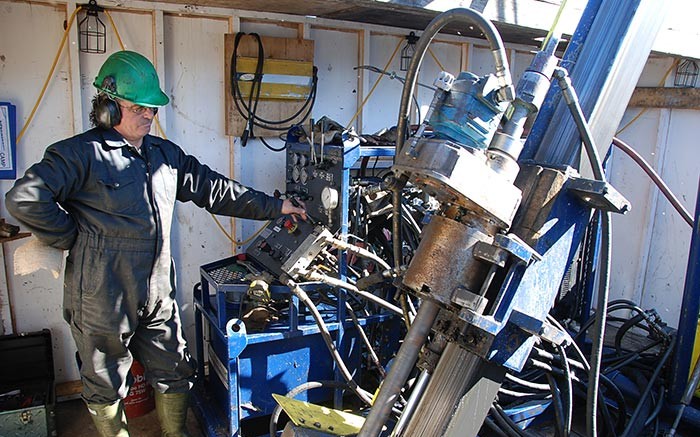VANCOUVER — North American Nickel (TSX-V: NAN; US-OTC: WSCRF) is making headway advancing its Maniitsoq nickel-copper-cobalt-platinum group metals property on the coast of southwestern Greenland, 85 km north of the capital Nuuk.
The property covers 2,954 sq. km and encompasses a large belt of highly prospective norite (an igneous intrusive rock) that is being investigated by Greenland government geologists as the aftermath of a giant meteorite impact 3 billion years ago. Around that time, Greenland was much closer to Canada’s Nain and Superior geological provinces, which host the giant Voisey’s Bay and Thompson nickel deposits in Labrador and Manitoba.
Though exploration at Maniitsoq is complicated due to strong host-rock deformation, the goal is to find the sulphidic, quiescent magmatic chambers that acted almost as an eddy for nickel mineralization next to the less prospective and diluted free-flowing dykes.
But North American Nickel’s (NAN) share price was hammered last August after the explorer released the first assay results of the year from the Imiak Hill complex — its most advanced target, in the northern reaches of the Maniitsoq property. The news sent its share price tumbling 40% to 33¢, and it has yet to recover, most recently trading at 22¢ after touching a 52-week low of 19¢.
In a phone interview, NAN’s vice-president of exploration Patricia Tirschmann says that last year, the company could have better promoted the property’s regional potential.
“Maniitsoq is a district scale project and Imiak Hill is just a tiny piece of it,” she says. Drawing on her 25 years of experience with nickel-sulphide deposits, she says she “can’t think of anywhere else that has this much nickel mineralization over such a large area and not have a head frame established yet. There’s a big camp-scale potential there, and not just at Imiak.”
NAN acquired the project in 2011, and since then the team has outlined over 200 anomalies that other explorers — such as Cominco and Falconbridge — had missed. NAN owes its reconnaissance success to a ground-hugging, helicopter-borne time-domain electromagnetic survey, as it provides an accurate view of highly conductive, potential orebodies lurking beneath the semi-rugged landscape.
In 2012 NAN focused on the Imiak Hill complex, which is composed of three targets — Imiak Hill, Spotty Hill and Mikissoq — occurring within 2 km.
Drilling in 2012 and 2013 cut shallow, near-vertical mineralization, with highlights including: 11.1 metres (true width) of 3.2% nickel and 1.1% copper in hole 13-28 at Imiak Hill; 123.9 metres (non-true width) of 0.8% nickel, 0.2% copper and 0.26 gram platinum, palladium and gold [or total precious metals (TPM)] per tonne in hole 12-5 at Spotty Hill; and 10 metres (not true width) of 4.7% nickel and 0.3% copper in hole 13-29 at Mikissoq.
NAN refocused most of its efforts in 2014 to extend the mineralization at depth but ran into trouble at Imiak Hill, when drilling encountered a shear zone rather than the target.
True width intercepts leading up to the offset had included 6.4 metres of 3.1% nickel, 0.5% copper at 220 metres deep in hole 14-37, and 1 metre of 3% nickel and 2.8% copper at 200 metres deep in hole 14-72, so when the uneconomic intercepts in the shear zone were released, the stock price fell hard on heavy trading.
“Expectations for Imiak Hill were extremely high and the market failed to look at the bigger picture,” Tirschmann argues, adding that more work is needed to determine the magnitude of the mineralization’s displacement. “There is still plenty of other low-hanging fruit at Spotty Hill, Mikissoq and our other regional targets that we can choose from.”
Spotty Hill, which is characterized by wide mineralized zones coupled with internal, high-grade near-massive sulphides, returned 66 metres of 0.6% nickel, 0.2% copper and 0.22 gram TPM from 17.4 metres in hole 14-62. The prospect is open to the southeast, and according to down-hole electromagnetic surveying, which measures conductive material up to a 100-metre radius, there appears to be continuity down-hole as well.
Adding to the 2014 results, drilling at Mikissoq intersected 61.4 metres of 0.6% nickel and 0.2% copper from 58 metres in hole 14-73, and it remains open to the northeast and down-plunge.
NAN also performed 3,725 metres of first-round drilling on its regional targets, and found mineralized norites at eight widespread locations, some boasting massive sulphides and nickel tenors up to 12%. Intercepts include 5.6 metres of 1.7% nickel and 0.3% copper in hole 58, and 20.1 metres of 0.6% nickel, 0.2% copper and 0.18 gram TPM in hole 30.
This year NAN is planning a multi-component exploration program in the thousands of metres. Tirschmann says the company intends to extend mineralization to depth at Spotty Hill and Mikissoq, follow up on promising regional targets defined last year and finish drill-testing regional targets.
North American is also evaluating the costs and benefits of securing an operational hub at Seqi port, located at the southern boundary of the Maniitsoq property. The ice-free port is amendable to dock-and-load vessels of up to 60,000 tonnes.
Tirschmann said during a January presentation at the Mineral Exploration Roundup conference in Vancouver that NAN wants to better position itself in what it considers the next big nickel-copper-cobalt camp, and considers itself fortunate to have two large shareholders backing it up: the Sentient Group and VMS Ventures, which own 41.2% and 22% of NAN’s shares.
With 170 million shares outstanding, North American has a $37.4-million market cap.


Be the first to comment on "North American Nickel gears up for work at Maniitsoq"